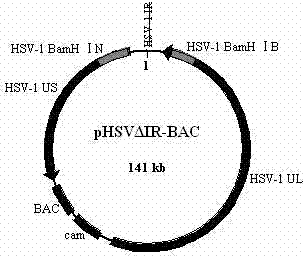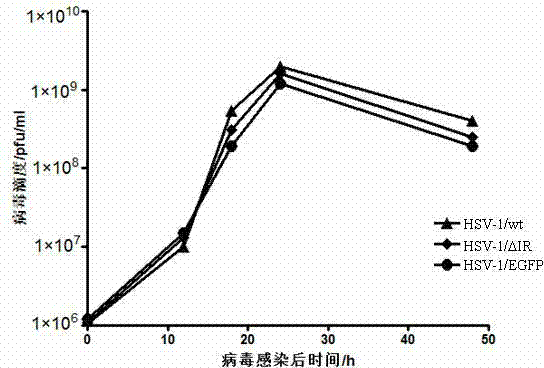Herpes simplex virus type 1 carrier system, and preparation method and application thereof
A technology of herpes simplex virus and vector system, applied in botany equipment and methods, biochemical equipment and methods, applications, etc., can solve the problems of time-consuming, time-consuming and laborious, cumbersome screening of recombinants, etc., and achieve weak toxicity, High safety effect
- Summary
- Abstract
- Description
- Claims
- Application Information
AI Technical Summary
Problems solved by technology
Method used
Image
Examples
Embodiment 1
[0023] Example 1. Preparation of shuttle plasmid pKo5 / BN
[0024] According to the genome structure of HSV-1, the Bam H IB fragment (B) and Bam The H IN fragment (N) is located on both sides of the IR region, respectively, and primers are designed according to the sequence of HSV-1, and respectively added to the 5' ends of the upstream and downstream primers of the B fragment Xba I and Speech Ⅰ Restriction site, added at the 5' end of the upstream and downstream primers of the N fragment respectively Eco R V and cla Ⅰ Restriction site, PCR amplification to obtain a 2024bp B fragment and a 2857bp N fragment, clone the B and N fragments into pBluescriptⅡKS(+) in sequence, and then include the B and N fragments and the multiple cloning site between the two fragments Cloning of the DNA fragment into pKO5 Xba I and Sal The shuttle plasmid pKo5 / BN (attached figure 1 ).
Embodiment 2
[0025] Embodiment 2. prepare HSV-1 bacterial artificial chromosome plasmid pHSV Δ IR-BAC
[0026] A large amount of pKo5 / BN was extracted and purified by alkaline lysis, 2μl (1μg / μl) of purified pKo5 / BN was mixed with 40μl DH10B competent cells and pre-cooled in an ice-water bath, and then added to a 0.1cm electric shock cup for electroporation. The parameters are voltage 2.5 kV, capacitance 30 μF and resistance 400Ω. The competent cells after electrotransformation were added to 1 mL of SOC medium and incubated at 30 °C for 1 h, spread on LB solid medium containing zeocin and chloramphenicol, and cultured at 43 °C overnight; when the colony grew to a diameter of about 1 mm, random Pick 10 single clones, mix them in 1 mL of normal saline, take 40 μL and spread them on LB solid medium plates containing chloramphenicol and 5% (v / v) sucrose, and culture them overnight at 30°C; Randomly pick 10 single clones (total 100 single clones) on each plate and streak on the solid LB me...
Embodiment 3
[0027] Example 3. Preparation of recombinant HSV-1 with deletion of IR region: HSV-1 / Δ IR
[0028] Vero cells were cultured according to conventional methods until the cell density reached 70%-80%, and the purified recombinant plasmid pHSVΔIR-BAC (set in three gradients of 2 μg, 4 μg and 8 μg) was transfected into cells by liposome-mediated method. Observe the pathological changes (CPE) of the transfected cells after 2 days, and plaques appear in the cells after 4 days (the cell state and transfection reagents will affect the transfection effect and cause the appearance time of plaques to lag); Discard the cell culture medium, fix the cells with an equal volume mixture of 2% low-melting point agarose and serum-free 2×199V medium, pick up the cells in the plaque area by conventional methods, and add 200 μL of skim milk powder solution (the mass volume of which has been sterilized by conventional autoclaving) Concentration of 9% skimmed milk powder solution) and 2×199V equa...
PUM
 Login to View More
Login to View More Abstract
Description
Claims
Application Information
 Login to View More
Login to View More - R&D
- Intellectual Property
- Life Sciences
- Materials
- Tech Scout
- Unparalleled Data Quality
- Higher Quality Content
- 60% Fewer Hallucinations
Browse by: Latest US Patents, China's latest patents, Technical Efficacy Thesaurus, Application Domain, Technology Topic, Popular Technical Reports.
© 2025 PatSnap. All rights reserved.Legal|Privacy policy|Modern Slavery Act Transparency Statement|Sitemap|About US| Contact US: help@patsnap.com



